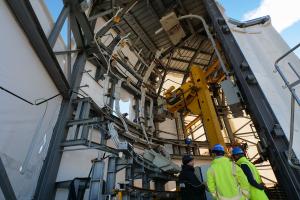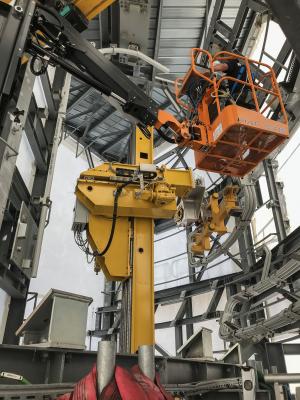Set of handling tools for in-vessel installation finalized
Inside of a test facility that reproduces the volume and geometry of the ITER vacuum vessel environment, a team from CNIM Systèmes Industriels has demonstrated that the tools it has designed for the installation of in-vessel components can carry out their tasks to better-than-required accuracy.
A tower crane glides silently on rails, its manipulator arm supporting a 4.5-tonne blanket shield block. The crane stops and pivots toward the outboard wall of the vacuum vessel mockup, then stands immobile as the payload is raised to the correct height. As the manipulator arm extends forward to position the shield block on the wall, two technicians advance to finalize the installation manually from a cherry picker...
The results achieved during this shield block test in early January 2023 were conclusive, with ITER observers recording a positional accuracy of 0.1 millimetres—even better than the 0.5 mm of accuracy stipulated in ITER Organizational technical specifications.
"Today we demonstrated that the in-vessel tower crane performs very well, and to our expectations," says ITER engineer John Oldfield, who has been in charge of managing the mechanical handling contract with CNIM Systèmes Industriels since 2016. "So in the future, when it installs the shield blocks [at ITER] it should do so very easily and quite quickly."
The January event concluded approximately one year of acceptance testing at the Trial, Test and Training Facility in La Seyne-sur-Mer (Toulon), France, during which bespoke technical solutions for the installation of four types of component systems that directly attach to the inner walls of the ITER vacuum vessel were tested successfully.
These components—blanket shield blocks, blanket first wall panels, cooling manifolds (bundles of piping), and in-vessel ELM coils—must be transferred mechanically through an ITER port cell and into the vacuum vessel, then positioned inside the vessel with as little operator intervention as possible.
Under a contract signed in 2015 with the ITER Organization, the team at CNIM Systèmes Industriels worked from ITER Organization concept designs to come up with innovative mechanical handling solutions. It also designed and built a scale-one trial and test facility—representing one-third of the ITER vacuum vessel and one adjacent port cell—to put the handling tools to the test in a realistic setting. Mockups for each type of component (similar in shape, mass and centre of gravity to the real thing) were designed and manufactured, as well as the interfacing elements, consisting of end effectors and handling frames, that permit the same tools to adapt to different components.
"There is no question; this has been a challenging set of tools to design," says Oldfield. "The tools have to handle components with very different shapes, weights and centres of gravity, and transfer them through the confined environment of an ITER port cell and into the vacuum vessel. They must be able to deliver the components to any position on the vacuum vessel inner wall, inboard or outboard. And the tools must achieve very high positional accuracy with a minimum of human intervention."
The principal tool is the in-vessel tower crane, a remote controlled mobile manipulator that travels 360° around the interior of the vacuum vessel on dedicated rails. It can carry loads of up to 5 tonnes and position them at any location inside the vacuum vessel to better than 0.5 mm accuracy. Two of these manipulators are planned.
The through-port transfer system will transport four categories of in-vessel components through any regular equatorial port with a gantry-crane-style carrying system. Once in the vacuum vessel, the components will be "picked up" by the in-vessel tower crane.
Finally, two electric cherry pickers sit on a custom base that can travel on the rails of the in-vessel tower crane, each carrying two technicians and their equipment for finalization operations.
"Technically, I can say that our partners have performed really well," says Oldfield. "We really appreciate the solution developed by CNIM for personnel access: to use standard cherry pickers adapted to run on the same bottom rails as the in-vessel tower crane—this is a solution we had not envisaged and it will offer our installation teams a lot of versatility, carrying them all over the chamber. It has also been really impressive to see how only two workers can carry out most component installation operations using the remote box. The tools are so effective that the process of transferring a component from the port cell to its final position on the vacuum vessel wall will not be a bottleneck in the overall in-vessel component assembly schedule."
Tests have now concluded in La Seyne, but the test facility will have a second life—it will be dismantled and delivered to ITER along with all tools and mockups. Re-assembled at ITER, it will serve as a facility for technician training facility and for the development and testing of in-vessel component assembly procedures.
Watch a video of the January tests at CNIM Systèmes Industriels here.




